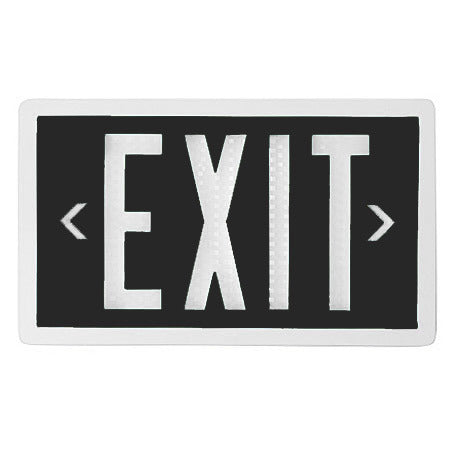5 Products
Tritium Exit Signs – Spec Guide
- Compliance & licensing: UL 924 listed; device must comply with federal/state radioactive materials regulations (e.g., general-licensed tritium signs). Verify AHJ acceptance and labeling requirements on submittals.
- Lifespan & activity: Specify rated life (e.g., 10/15/20-year). Confirm initial brightness/activity and expected end-of-life luminance; ensure legend remains readable for the full rated period.
- No-power operation: Self-luminous—no AC, batteries, or charging light required. Use where wiring is impractical or prohibited; confirm visibility under site ambient conditions (very bright/daylight areas may favor other technologies).
- Legend & visibility: Red or green letters with uniform illumination; verify character height and viewing distance (e.g., 6″ letters commonly specified to ~100 ft—model dependent). Maintain clear sightlines on approach paths.
- Faces & direction: Single/double-face options. Confirm arrow/chevron availability and method (factory or field-applied) to match egress direction and standardize SKUs across floors/zones.
- Housing & environment: Choose enclosures (thermoplastic, aluminum, or FRP) suitable for indoor/outdoor use; check impact resistance, UV stability, and any damp/wet or enclosure (NEMA/IP) ratings if required by the site.
- Mounting & clearances: Wall/ceiling/end mounting with appropriate canopy/plate. Verify projection, headroom, and separations from sprinklers/detectors/signage; ensure label visibility after install.
- Markings & records: Confirm permanent expiration/date labels, serial/model, and radiation caution markings. Maintain inventory/recordkeeping per facility policy for inspections and audits.
- Handling & EOL: Establish end-of-life return plan to an approved recycler; follow chain-of-custody and packaging requirements for transport/disposal of tritium devices.
Additional Resources
FAQs About Tritium Exit Signs
Is a Tritium Exit Sign Right for My Building?
Tritium exit signs are ideal for facilities where electrical wiring is impractical or unavailable—such as tunnels, outdoor enclosures, or mechanical spaces. They are also excellent for reducing maintenance costs over time, since they require no batteries or electrical connections. Most buildings that fall under UL 924 and NFPA 101 compliance can use them, but check with your local fire marshal for location-specific restrictions.
When to Use Tritium Exit Signs (No Power Required)
Use tritium exit signs in any area without consistent light exposure or electrical power. These include stairwells, emergency egress paths, military shelters, underground parking structures, and storage vaults. Their 10- or 20-year lifespan and self-luminous design make them an excellent “set it and forget it” solution for safety lighting.
How Do Tritium Exit Signs Work?
These signs use tritium gas to emit light continuously without electricity. Tritium emits low-energy beta radiation that excites phosphor coatings inside the sign, producing visible glow.
Are Tritium Exit Signs Safe?
Yes. Tritium signs are sealed and regulated by the NRC. They emit low levels of radiation that are safe under normal use and pose no threat when intact.
What Are the Disposal Requirements?
Tritium signs must be returned to a licensed facility for proper radioactive disposal. Never discard them in regular waste streams.
Are There Alternatives to Tritium Signs?
Yes. In areas with consistent lighting, photoluminescent exit signs offer a non-radioactive, power-free alternative.
Do Tritium Signs Expire?
Yes. Depending on the model, they last 10, 15, or 20 years. Each sign includes an expiration date and must be properly disposed of when it reaches end-of-life.
What Is a Nuclear Exit Sign?
“Nuclear exit sign” is a common term for a tritium exit sign, which uses radioactive tritium gas to emit light continuously without electricity. These signs are self-powered, safe under normal use, and require no maintenance for 10–20 years.
Do Tritium Exit Signs Meet UL 924 and NFPA 101?
Yes. All tritium exit signs sold here are UL 924 listed and compliant with NFPA 101 and OSHA life safety code requirements when installed properly.





